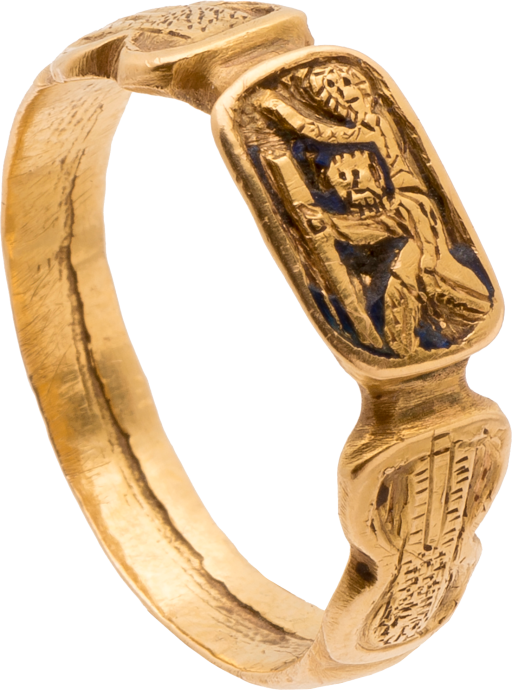


Iconographic Ring with St. Christopher
, c. 1450-70

Iconographic Ring with St. Christopher
Description
In the Middle Ages rings with devotional scenes and favorite saints were worn not only as a sign of faith, they also often had a more personal significance for the wearer. Saints were venerated as patrons of a shared name, or a profession, for example a patron saint which represented a particular guild. More often though the belief was that saints could accompany the wearer through life, bring prosperity, heal from disease, or protect the wearer from the dangers of life. In the late fourteenth century the image of Saint Christopher protected against sudden death, but he was also known as the patron saint of travelers. The scene on the ring portrays the legend of the saint who carried the Christ Child over his shoulder across a river. Such rings made of gold, silver, or silver-gilt were popular in England and Scotland, and described as "iconographic" by Victorian ring collectors.
The flat, yet rounded hoop widens towards the shoulder to form a buckle shape on either side. The oblong bezel is engraved with the scene of St. Christopher bearing the Christ Child. Traces of blue enamel are evidence of age and wear. The ring is in good condition.
Provenance:
Prior to 1990 the ring belonged to a private British collection.
Literature:
St. Christopher was very popular and can be found on many iconographic rings. For the ring type, cf. examples in the British Museum, London (Dalton 1912, pp. 111-119); Victoria and Albert Museum, London (Bury 1984, p. 184ff.; Church 2011, pp. 20-22). Cf. also Scarisbrick 2007, pp. 136-138. For other examples of rings with belt buckles, cf. examples in the British Museum, (AF 662), Victoria & Albert Museum (Church 2011, no. 19) and the from the Colmar Treasure, Musée de Cluny, Paris (Cl. 14943).